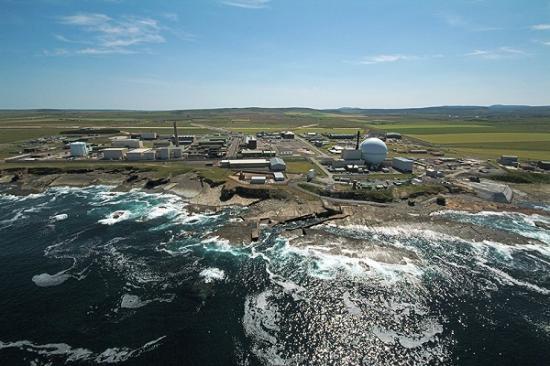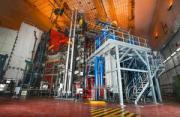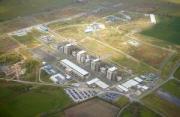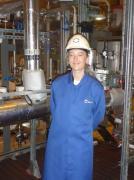Dounreay Has Successfully Joined With Magnox Limited
3rd April 2023

Dounreay has successfully joined with Magnox Limited, effective as of April 1st 2023.
This joining is part of the NDA group's wider programme of change.
First bringing together the organisations involved in delivering its decommissioning mission into one group, and then strengthening and simplifying the operating model around four operating companies: Magnox and Dounreay; Sellafield; Nuclear Transport Solutions and Nuclear Waste Services.
As part of the new arrangements, the Nuclear Site Licence for Dounreay is now held by the Magnox Limited Board. There will be no fundamental change to the current work programmes at the Magnox sites or Dounreay. The focus remains on decommissioning the sites safely, securely and cost-effectively.
Magnox Sites
Magnox is responsible for defuelling and decommissioning 12 nuclear sites and operating one hydro-electric plant in the UK.
Magnox is licensed under the Nuclear Installations Act 1965 as the legal entity responsible for the following sites, which are owned by the Nuclear Decommissioning Authority.
Berkeley Site
Berkeley Site is located on a 27 hectare site of special scientific interest on the bank of the River Severn in Gloucestershire. The site generated 43 terawatt hours of electricity during its 27 years of operation and shut-down in 1989. Berkeley is in its decommissioning phase and has completed a number of key activities, including disposing of its 310 tonne boilers and entering both reactors into a safestore state. Priorities for the site now include removing all legacy wastes and emptying the active waste vaults.
Bradwell Site
Bradwell Site is located on a 30 hectare site close to the Essex coastline. The site generated 60 terawatt hours of electricity during its 40 years of operation and shut-down in 2002.
Bradwell is following an accelerated decommissioning programme, due for completion late in 2018. This will see it become the first reactor site in the UK to enter the care and maintenance phase. The majority of decommissioning activities are now complete, including the conditioning of all intermediate level waste. The final projects to be completed include cladding reactor two and installing a pond and vaults over clad building.
Chapelcross Site
Chapelcross Site is located on the 92 hectare site of an old airfield in Dumfriesshire. The site stopped operating in 2004 after generating more than 60 terawatt hours of electricity over 45 years. The site completed defuelling ahead of schedule and is now in its decommissioning phase. Priorities including the design, installation and commissioning of plant and equipment to safely recover intermediate level waste from buildings and the former cooling ponds.
Dungeness A Site
Dungeness A Site is located on a 22 hectare site of special scientific interest on the Kent coast. The site stopped generating electricity in 2006 with a lifetime output of 120 terawatt hours. The site is now in its decommissioning phase and is making steady progress, including demolishing its turbine hall and decontaminating its ponds. Priorities for the site now include draining reactor one pond, resin retrieval and packaging.
Harwell Site
Harwell Site is located on a 102 hectare site in Oxfordshire and is the birthplace of the UK nuclear industry. Originally an RAF station, it became Britain's Atomic Energy Research Establishment in 1946. There were 14 experimental reactors on the site over its lifetime, with just three remaining to be decommissioned. Significant progress is being made in decommissioning the site, with waste being treated, sorted and disposed of and the construction of a new intermediate level waste store.
Hinkley Point A Site
Hinkley Point A Site is located on a 19 hectare site on the Somerset coast. It is a twin reactor site which stopped generating electricity in 2000 having completed 35 years of operation, generating 103 terawatt hours. Hinkley Point A Site is now being decommissioned and its focus is on the safe and secure retrieval, packaging and storing of its legacy waste. Priorities for the site include completing the build and commissioning of the intermediate level waste store and installing the modular active effluent treatment plant.
Hunterston A Site
Hunterston A Site is located on a 36 hectare site on the Ayrshire coast. The twin reactor site stopped generating electricity in 1989 after producing 73 terawatt hours. Hunterston is part way through its decommissioning phase, with the current focus on recovery of intermediate level waste from various facilities and final decommissioning of the cartridge cooling ponds, which have already been drained of water.
Oldbury Site
Oldbury Site is located on a 39 hectare site on the bank of the River Severn in South Gloucestershire. It stopped generating in February 2012 after 44 years, generating 137.5 terrawatt hours of electricity.
The site completed defuelling in 2016 and moved into its decommissioning phase. Progress has been made in the former cooling ponds and an alternative electrical supply has been installed on the site, allowing disconnection from the national grid. Priorities are completion of ponds decommissioning work and retrieving, packaging and conditioning other forms of radioactive waste on site. Conventional demolition work will also begin to reduce the footprint of the site.
Sizewell A Site
Sizewell A Site is located on a 10 hectare site in Suffolk. The site generated 110 terawatt hours of electricity during its 40 years of operation and shut-down in 2006. The site is in its decommissioning phase and the focus is now firmly on waste management and hazard reduction, with the cooling ponds the current priority. Two major projects to accelerate demolition work have been completed, removing the cooling water crane and the two off-shore structures. Building demolition continues with a number of facilities being dismantled and cleared, including the administration building, engineering building and C02 plant. The demolition of the National Grid sub-station has been completed.
Trawsfynydd Site
Trawsfynydd Site is located on a 15 hectare site in Snowdonia National Park, Gwynedd. It drew cooling water from Llyn Trawsfynydd, which was formed in 1928 to retain water for Maentwrog Hydroelectric Station. Trawsfynydd generated 69 terawatt hours of electricity during 26 years of operation and shut-down in 1993. The site is decommissioning and key successes include bulk asbestos removal and storage of all solid intermediate level waste, resins and liquid in the interim storage facility. Site infrastructure has been upgraded, redundant buildings demolished and the reactor safestores are being reconfigured in preparation for a major project to reduce their height by around two thirds.
Winfrith Site
Winfrith Site is located on a 129 hectare site in Dorset. It was constructed in the 1950s to enable vital research into reactor design. The site housed nine experimental reactors at various times with only two remaining today, both of which are being decommissioned. Fifty hectares of the site was transferred to different ownership in 2003 following its decommissioning and progress since has seen the skyline change dramatically. Ponds have been emptied, bulk asbestos removed and waste sorted. Winfrith is working towards reaching its interim end state, at which point the land will be returned to heathland with public access.
Wylfa Site
Wylfa Site is located on a 20 hectare site on the north coast of Anglesey. It was the last and biggest of the Magnox stations to be built. It was shut down in 2015 having completed almost 45 years of operation, generating a total of 232 terawatt hours of electricity. The site has now been defuelled and a remediation project is underway to remove and clean asbestos from areas within the reactor buildings and turbine hall.
Wylfa is also responsible for the Maentwrog hydroelectric station near Blaenau Ffestiniog, Gwynedd, which continues to generate electricity.
Nuclear Decommissioning Authority
Dounreay Site Restoration Ltd (DSRL) and LLW Repository Ltd (LLWR) became wholly owned subsidiaries of the NDA in 2021.
Related Businesses
Related Articles
TAE Technologies and UKAEA partner to commercialise fusion tech
Joint venture to develop neutral beams for fusion and non-fusion applications, creating high-skilled jobs and establishing a critical supply chain. TAE Technologies, a leading US private fusion energy firm with over 25 years at the forefront of scientific innovation, today announces a bilateral and reciprocal investment commitment with the United Kingdom's national fusion laboratory, the UK Atomic Energy Authority (UKAEA) to commercialise TAE's proprietary particle accelerator technology for the global market.
Buried Hazards, Unfinished Business - What the NDA's 2025 Progress Report Really Tells Us
The Nuclear Decommissioning Authority (NDA) has released its 2025 Mission Progress Report is a slightly sprawling document chronicling one of the UK's most complex environmental undertakings. The safe dismantling of its early nuclear legacy.
New recruit officers join the Civil Nuclear Constabulary
The Civil Nuclear Constabulary (CNC) welcomes its newest recruits. The CNC hosted two passing out parades for the graduating Authorised Firearms Officers (AFOs) of Initial Foundation Programme (IFP) 106.
Dounreay's next generation of talent honoured by apprentice award
Nuclear Restoration Services Dounreay's Kate Thomson has won Modern Apprentice of the Year at the Highlands & Islands Apprenticeship Awards in Inverness. Kate, who is in the second year of her apprenticeship in commercial and quantity surveying, said she was thrilled by the honour.
Taskforce calls for radical reset of nuclear regulation in UK
Nuclear Regulatory Taskforce publishes final report and calls for radical reset of overly complex nuclear regulatory system. An overly complex nuclear regulatory system has contributed to the "relative decline" of the UK's ability to deliver faster and cheaper nuclear projects.
NDA working with private developer to accelerate Chapelcross Hub
The NDA group has announced it's working with CX Power as the strategic developer to support the delivery of the green energy hub masterplan at Chapelcross. The Nuclear Decommissioning Authority (NDA) group has announced it's working with CX Power as the strategic developer to support the delivery of the green energy hub masterplan at Chapelcross, a programme set to transform the region.
Funding approved for Wick Harbour port consultant
A specialist ports consultant has been appointed to develop a long-term strategic plan for Wick Harbour Authority (WHA) in Caithness. WHA has secured £47,775 from Highlands and Islands Enterprise (HIE) and the Nuclear Restoration Services, NRS Dounreay towards the cost of the services.
NDA announces £1 million funding to accelerate clean energy in West Cumbria
NDA announces £1 million investment to develop masterplan for clean energy development on land adjacent to Sellafield. The Nuclear Decommissioning Authority (NDA) has announced today it's investing £1 million of funding to develop the masterplan for a clean energy development on land adjacent to Sellafield, known as Pioneer Park.Fallon Campbell From Melvich Near Thurso Named As Apprentice of the Year At Awards In London
Rising star from North Scotland honoured at event to celebrate brightest and best in industry. An electrical apprentice from North Scotland is celebrating after being recognised for her contribution to industry at the 13th annual Engineering Construction Industry ECI Training and Development Awards in London.
The NDA Group Graduate Programme: more than a job
The NDA group graduate scheme offers far more than just a stepping stone into the nuclear industry; it's a chance to grow professionally, explore new places, and become part of a supportive community. Nuala Ledward, Assurance and Performance Graduate, shares how her secondment to Dounreay brought these benefits to life.
